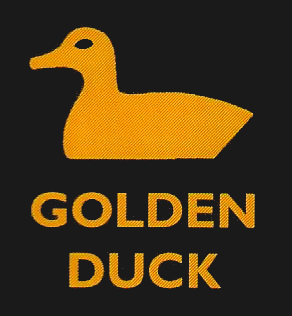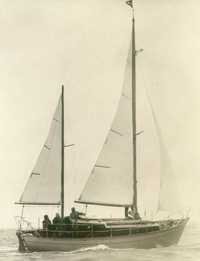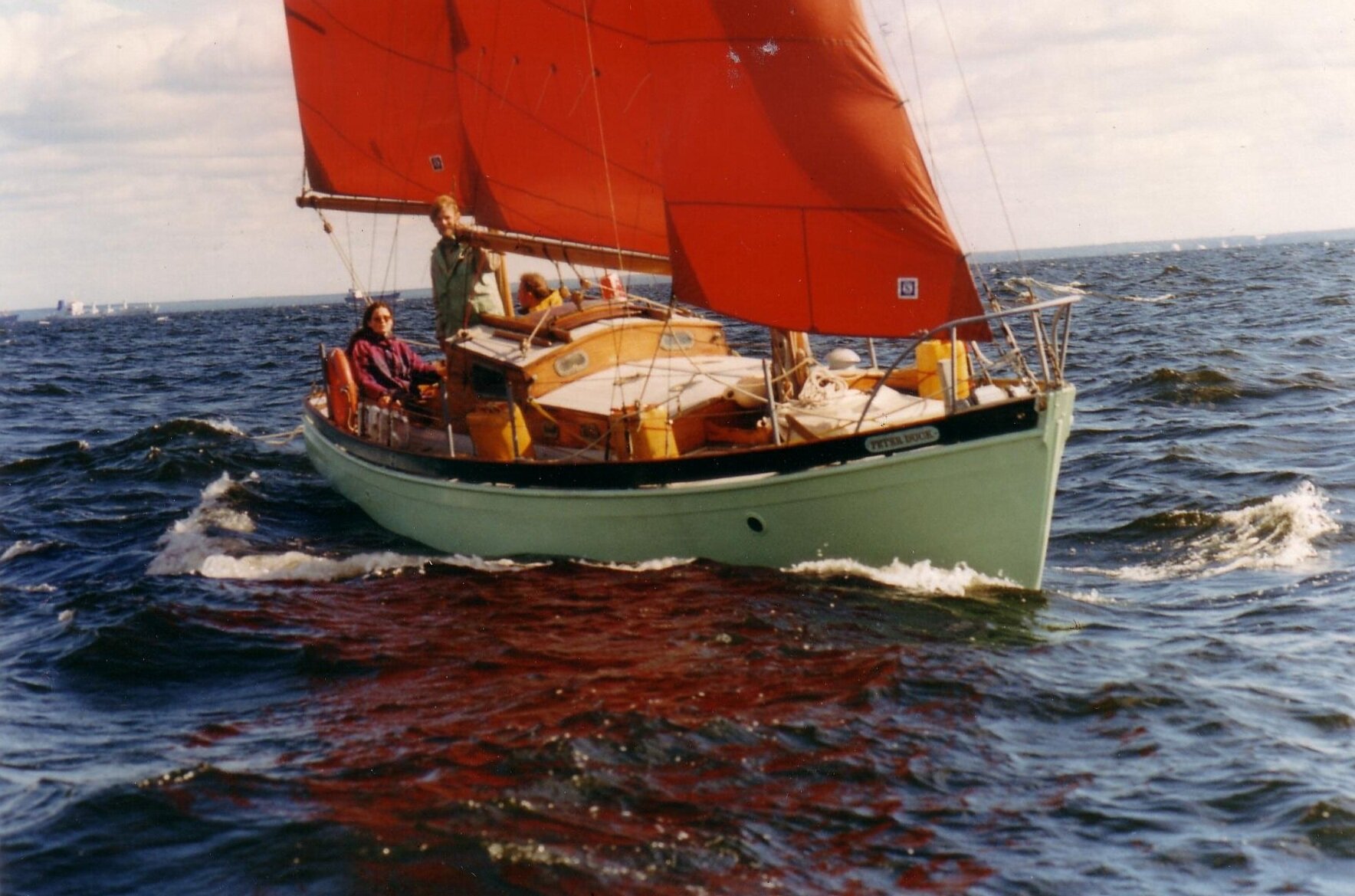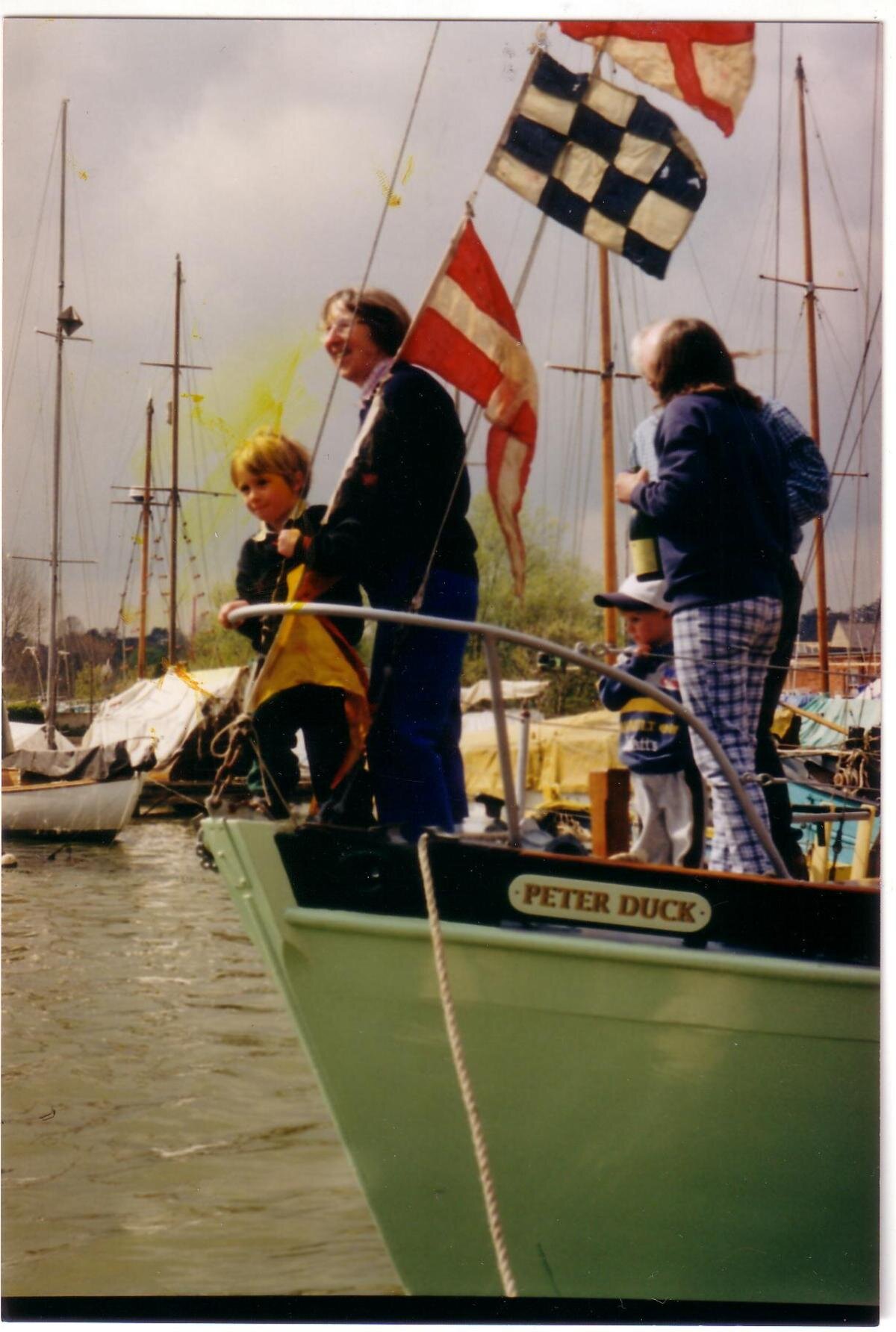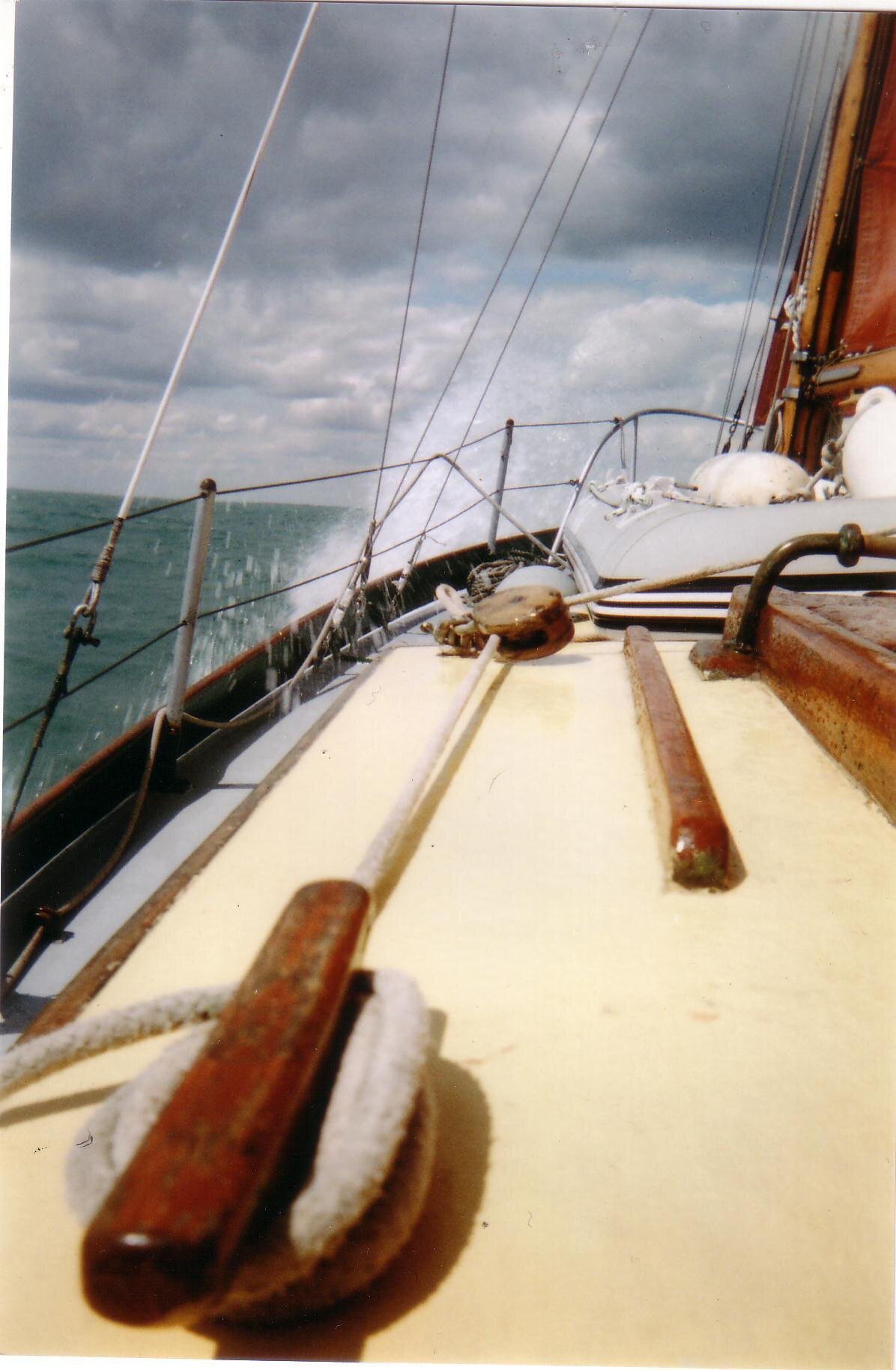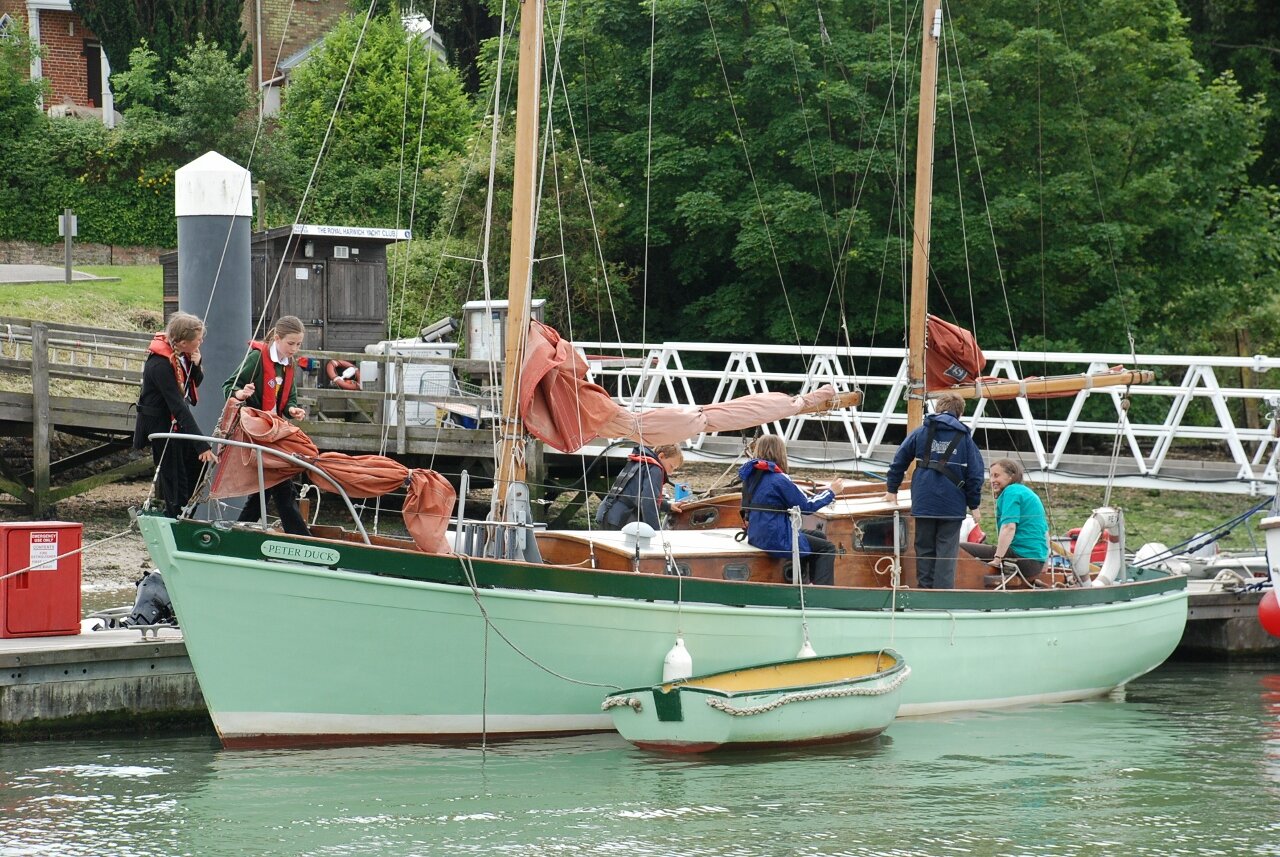Peter Duck is a 28ft Bermudan ketch designed by Jack Laurent Giles and built in 1946 at Harry King’s yard in Pin Mill for Arthur and Evgenia Ransome.
Design
Original
Peter Duck was designed by Jack Laurent Giles and his partner Humphrey Barton. She was commissioned in 1945 soon after the end of WW2, one of the first new-builds of the post war era. Ransome had been advised by his doctor that his pre-war yacht Selina King (also built in Pin Mill) was too heavy for him as age and infirmity took its toll. He wasn’t happy about this and famously referred to Peter Duck as his ‘marine bath chair’. The year that Peter Duck was launched was also the year his last Swallows and Amazons book, Great Northern? was published. It’s possible that one underlying reason why he never really warmed to the boat was that she came at the wrong time in his life.
Class
There’s a Peter Duck class of yachts, mainly built by Porter and Haylett of Wroxham in Norfolk during the later 1960s. They were the brain-child of George Jones (PD’s owner from 1957 - 1983) encouraged by his brother Jack, a naval architect. Both of them appreciated the sea kindly qualities and easy handling of the original Peter Duck but assumed 1960s owners might want a little more headroom and a more powerful engine. 38 were built; some have stayed in the UK while others have cruised more widely. Being solidly built of good materials they’ve generally stood the test of time better than many wooden boats of their era. The design is still available to purchase from the Laurent Giles archive.
Owners
1945-1949: Arthur and Evgenia Ransome
In Arthur Ransome’s third — and possibly most far-fetched (though Missee Lee comes close) — novel, the eponymous old seaman ‘Peter Duck’ represents solid common sense and maturity. “Anything might happen to Peter Duck and he would always come out alright,” the children thinks Able-seaman Titty. In Swallowdale ‘Peter Duck’ is Titty’s imaginary friend, always ready for an adventure. Ransome had modelled the character on an actual person, the old Baltic seaman Carl Herman Sehmel (‘The Ancient Mariner’) who sailed with Arthur and Evgenia in the ketch Racundra in 1921.
‘The Ancient Mariner’ on Peter Duck
The design process was somewhat fraught misunderstanding and ill-temper but Ransome had a full season’s East Coast sailing Peter Duck during 1947. His log entries tend to be dissatisfied — whether due to deck leaks (there was little properly seasoned timber available so soon after WW2) or the unreliable engine. He also seems to have found her difficult to handle. Subsequent owners have disagreed, finding her very handy (for a motor sailor). A particularly thoughtful article by Greg Palmer suggests that Ransome may have failed to come to terms with PD’s lack of weather helm. She is a particularly well-balanced boat in a post-war style that he’d not previously experienced. He kept her scarcely three years after her launch before moving back to the Lake District and putting her up for sale.
Peter Duck, October 1946
1957-1984: George and June Jones
Ransome’s loss was eventually the Jones family’s gain. Peter Duck had moved to the South Coast (where Ransome noted she had been painted blue) but George Jones, Julia’s father, was a yacht agent who encountered Arthur and Evgenia Ransome in 1951 when, with characteristic restlessness, they returned once again to Suffolk for some sailing. At that time they rented George and June Jones’s Hillyard-designed yacht Barnacle Goose. When Peter Duck was once again on the market, the Jones family was growing and Barnacle Goose beginning to feel a little cramped. George Jones was asked to act as the agent but bought her for himself. This was 1957 when Julia was not quite three years old and her brother Nick just fifteen months.
Entering the Deben, early 1960s
June Jones with Nick and Julia
Peter Duck was the key element in Julia’s childhood. She was based at Woodbridge and Waldringfield on the River Deben and remained a central part of family until George’s sudden death in 1983. June did her best to maintain her (with help from the youngest child Ned) but it was a lonely task and at that time PD needed significant maintenance and more attention that anyone in the family was able to give her. She was once again sold.
On the scrubbing posts at Waldringfield
Julia Jones on Peter Duck
1987-1999: Greg and Ann Palmer
After a single brief ownership Peter Duck was bought by Greg and Ann Palmer in 1987. “Three Million Cheers,” Ann wrote in her log book. They and their son (another Ned) were her most adventurous, imaginative and intrepid owners. Peter Duck is a fine sea-boat and the Palmers explored her potential as never before. They started small, pottering around the peaceful Deben, then venturing to the Alde or the Walton Backwaters but then Greg’s vision and determination extended their horizons. He and Ned took her round Britain in 1991; then to the Baltic in 1993 and 1995.
In Poland, 1995
Leaving St. Petersburg, 1999
For a few years Peter Duck’s home was in St Petersburg, where Greg (a historian) was involved in the project to build a replica of Peter the Great’s flagship Shtandart but then Greg died, unexpectedly and far too young - as George Jones had done, fifteen years before. Ann and Ned took the same hard decision that June had previously done that Peter Duck needed new owners if she was to be maintained in seaworthy condition for the future. With John Robinson as skipper and a crew of young Russian volunteers Peter Duck sailed home to Woodbridge. The crew may have been pumping all the way and her topsides may have looked like baggywrinkles but for Julia and her brother Ned PD’s return to the Ferry Quay was a wonderful emotional moment — better still when Francis agreed that they should make an offer to buy her.
Julia Jones with Ann Palmer on Peter Duck, 2000
1999-present: Julia Jones and Francis Wheen
In Other People’s Dreams, an essay written for the Aldeburgh music festival programme, Julia tried to describe what it meant to her when she heard that Peter Duck was back in the River Deben. Extensive renovation was needed to counteract ice damage from the marshes near St Petersburg but by 2000 PD was back in home waters. Since that date she has welcomed four generations of the Jones family: from June, who made her last trip on board when she was 91, to Julia’s own grandchildren, three of whom have become particularly keen young sailors.
Over the last fifty years Peter Duck has put Julia through the gamut of emotions. Among her most treasured memories is the day she gave her son Bertie, then aged eleven, her first children’s novel, The Salt-Stained Book, written in partial homage to Ransome. Bertie settled down in Peter Duck’s cabin to read it and would not be disturbed, continuing as Julia rowed him up the river in the dinghy and finally finishing the story on board Goldenray. As a young adult Bertie is the most regular member of PD’s crew and has also enjoyed taking her away on his own. For Julia she remains a uniquely special place.
Bertie meets Peter Duck, 1999
